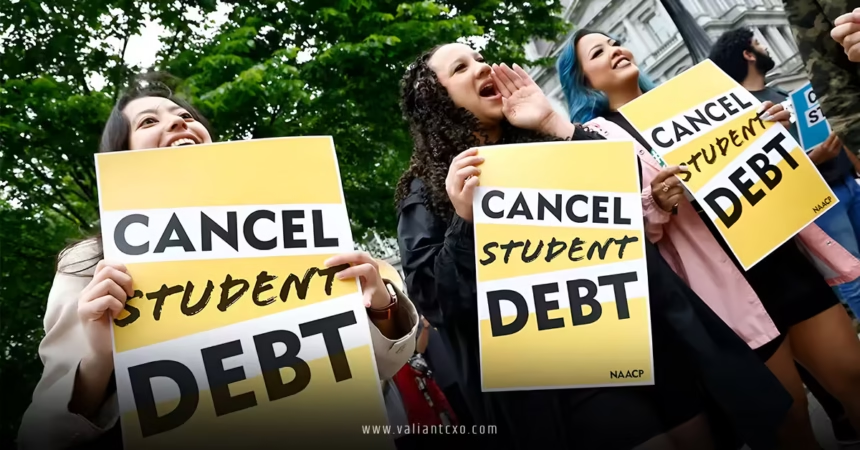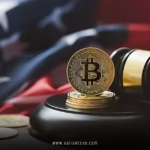How the US Government Is Tackling Student Loan Debt Crisis is a question on the minds of millions of Americans drowning in over $1.8 trillion of student loan debt. Picture this: a generation weighed down by the financial equivalent of a boulder, struggling to buy homes, start families, or even save for retirement. The student loan debt crisis isn’t just a number—it’s a life-altering burden for 45 million borrowers. But what’s the government doing about it? Is it enough, or are we just slapping Band-Aids on a broken system? In this article, we’ll dive deep into the strategies, policies, and debates surrounding how the US government is tackling the student loan debt crisis, breaking it down in a way that’s clear, engaging, and actionable.
The Roots of the Student Loan Debt Crisis
Before we explore how the US government is tackling the student loan debt crisis, let’s understand why we’re in this mess. Student loan debt has skyrocketed over the past few decades, outpacing inflation and wages. Back in the 1980s, a college degree was affordable for many without borrowing a dime. Fast forward to 2025, and the average borrower owes around $88,000, with some facing six-figure debts. Why? Tuition costs have ballooned, state funding for public colleges has dwindled, and the federal government’s loan programs have made borrowing easier than ever. It’s like handing out credit cards at a candy store—tempting, but dangerous.
The crisis isn’t just about numbers. It’s about the human toll. Young professionals delay major life milestones, like buying a house or starting a family, because their paychecks are eaten up by loan payments. Communities of color are hit hardest, with Black and Latino borrowers facing higher default rates. So, how is the US government stepping in to fix this? Let’s break it down.
How the US Government Is Tackling Student Loan Debt Crisis: Key Strategies
The US government has rolled out several initiatives to address the student loan debt crisis, from forgiveness programs to repayment reforms. These efforts aim to ease the burden on borrowers while balancing the interests of taxpayers. Below, we’ll explore the major approaches, their impacts, and what they mean for you.
1. Student Loan Forgiveness Programs
One of the most talked-about ways how the US government is tackling the student loan debt crisis is through forgiveness programs. The Biden administration, in particular, made headlines with ambitious plans to cancel significant chunks of debt. By 2025, the administration has approved nearly $153 billion in debt cancellation for over four million borrowers. Sounds like a lifeline, right? But there’s a catch.
Public Service Loan Forgiveness (PSLF)
The Public Service Loan Forgiveness (PSLF) program is a cornerstone of federal efforts. It promises to forgive the remaining debt for borrowers working full-time in public service jobs—like teachers, nurses, or nonprofit employees—after 120 qualifying payments. As of 2025, over $46.8 billion has been forgiven through PSLF, helping around 1.4 million borrowers. Imagine working a decade as a teacher and finally seeing your loans vanish—that’s the dream PSLF sells.
But it’s not all rosy. The program has been criticized for its complexity and low approval rates in the past. Many applicants were rejected due to paperwork errors or confusion over qualifying payments. The government has since streamlined the process, but it’s still a bureaucratic maze. If you’re eyeing PSLF, double-check your eligibility on the Federal Student Aid website.
Borrower Defense to Repayment
Another avenue is the Borrower Defense to Repayment program, which cancels loans for students misled by their schools—think shady for-profit colleges promising jobs that never materialize. This program has been a game-changer for some, with billions forgiven for victims of institutions like Corinthian Colleges. It’s a targeted way how the US government is tackling the student loan debt crisis, focusing on those wronged by predatory schools.
2. Income-Driven Repayment (IDR) Plans
How the US government is tackling the student loan debt crisis also involves making repayment more manageable. Income-Driven Repayment (IDR) plans tie your monthly payments to your income and family size, ensuring you’re not choosing between groceries and loan bills. The Saving on a Valuable Education (SAVE) plan, introduced under Biden, was a flagship IDR option, calculating payments based on a lower percentage of your income than older plans.
However, the SAVE plan hit a roadblock in 2025 when federal courts ruled it unlawful, forcing millions of borrowers to transition to other plans like the Income-Based Repayment (IBR) plan. The government is now enhancing IDR processes, simplifying enrollment, and eliminating annual income recertification. These changes aim to keep payments affordable, but the legal battles highlight a key challenge: political and judicial pushback can derail even the best-intentioned reforms.
3. Resuming Loan Collections with a Focus on Fairness
During the COVID-19 pandemic, the government paused federal student loan payments, offering relief to millions. But by October 2023, payments resumed, and by May 2025, the Department of Education restarted collections on defaulted loans. This move, part of how the US government is tackling the student loan debt crisis, aims to protect taxpayers by ensuring borrowers repay what they owe. Over 5 million borrowers are in default, and nearly 4 million are in late-stage delinquency, putting pressure on the system.
To ease the transition, the government launched a robust outreach campaign, using emails, social media, and tools like the Loan Simulator and AI Assistant (Aiden) to help borrowers choose repayment plans. The goal? Prevent defaults from spiraling while offering clear paths to financial stability. It’s like a financial GPS, guiding borrowers back to the road of repayment.
4. Addressing For-Profit College Abuses
For-profit colleges have been a major driver of the student loan debt crisis, with students at these schools defaulting at rates as high as 52%. The government has cracked down on these institutions, strengthening oversight and pursuing legal action against fraudulent schools. By targeting the root causes—like deceptive marketing and low-value degrees—the US government is tackling the student loan debt crisis proactively. It’s like pulling weeds from a garden to prevent them from choking the flowers.
Challenges in How the US Government Is Tackling Student Loan Debt Crisis
Despite these efforts, the road to resolving the crisis is bumpy. Legal challenges have been a major hurdle. The Supreme Court struck down Biden’s sweeping debt forgiveness plan in 2023, arguing it overstepped executive authority. Political divides also complicate things—some argue forgiveness unfairly burdens taxpayers, while others see it as essential for economic equity. It’s a tug-of-war between compassion and fiscal responsibility.
Then there’s the issue of complexity. Navigating loan forgiveness or repayment plans can feel like decoding a foreign language. Borrowers often struggle with unclear guidelines or unresponsive loan servicers. The Consumer Financial Protection Bureau reported over 14,000 complaints about loan servicers in 2024 alone. Clearly, the system needs a user-friendly overhaul.
The Human Impact: Why It Matters
Let’s get real—behind the numbers are real people. A single mom working as a nurse, juggling loan payments and childcare. A young graduate skipping meals to cover interest. The student loan debt crisis isn’t just a policy issue; it’s a personal one. By focusing on how the US government is tackling the student loan debt crisis, we see efforts to restore hope. Forgiveness programs give public servants a light at the end of the tunnel. IDR plans offer breathing room. But for every step forward, there’s a reminder of how far we have to go.
The crisis disproportionately affects marginalized groups. Black borrowers, for example, are more likely to borrow and default, perpetuating wealth gaps. By targeting relief to low-income and minority borrowers, the government aims to level the playing field. It’s not just about dollars—it’s about giving everyone a fair shot at the American Dream.
Future Directions: What’s Next?
So, where do we go from here? How the US government is tackling the student loan debt crisis will evolve with new administrations and economic realities. The Trump administration, starting in 2025, has signaled a shift toward fiscal responsibility, phasing out programs like SAVE and emphasizing repayment. Yet, the need for relief remains undeniable. Here are some potential paths forward:
- Free or Subsidized College: Some propose making public colleges tuition-free, reducing the need for loans. This could transform higher education but faces steep political and budgetary hurdles.
- Employer Incentives: Tax breaks for companies offering student loan repayment benefits could shift some burden off the government.
- Stricter Oversight: Tighter regulations on colleges, especially for-profits, could prevent future debt bubbles.
The government’s role isn’t just about fixing today’s crisis—it’s about preventing tomorrow’s. By addressing tuition inflation and promoting affordable education, we can stop the cycle of debt before it starts.
Practical Tips for Borrowers
While the government works on systemic fixes, what can you do? Here are some actionable steps:
- Explore Forgiveness Options: Check if you qualify for PSLF or Borrower Defense at StudentAid.gov.
- Enroll in IDR: Use the Loan Simulator to find a plan that fits your budget.
- Stay Informed: Follow updates on Federal Student Aid’s X account to avoid scams and know your options.
- Contact Your Servicer: If you’re struggling, reach out early to avoid default.
It’s like taking control of a stormy sea—small, deliberate actions can keep you afloat.
Conclusion
How the US government is tackling the student loan debt crisis is a complex, evolving story. From forgiveness programs like PSLF to repayment reforms and crackdowns on predatory colleges, the government is trying to ease the burden on 45 million borrowers. Yet, legal setbacks, political divides, and systemic flaws remind us that the crisis won’t vanish overnight. For borrowers, it’s about staying proactive—exploring options, seeking help, and advocating for change. The road ahead is long, but every step toward relief brings us closer to a future where education doesn’t come with a lifetime of debt. So, take heart, stay informed, and keep pushing forward. Your financial freedom is worth fighting for.
FAQs
1. What is the main way how the US government is tackling the student loan debt crisis?
The US government is tackling the student loan debt crisis primarily through forgiveness programs like Public Service Loan Forgiveness (PSLF) and Borrower Defense to Repayment, alongside Income-Driven Repayment (IDR) plans to make payments affordable based on income.
2. How does the Public Service Loan Forgiveness program work?
PSLF forgives federal student loans for borrowers working full-time in qualifying public service jobs after 120 qualifying payments. It’s a key part of how the US government is tackling the student loan debt crisis, helping teachers, nurses, and others.
3. Why was the SAVE plan discontinued?
The SAVE plan, an IDR option, was ruled unlawful by federal courts in 2025, leading to its phase-out. The government is now transitioning borrowers to other plans, a shift in how the US government is tackling the student loan debt crisis.
4. Can I get my loans forgiven if I was misled by my college?
Yes, through the Borrower Defense to Repayment program, you can apply for loan forgiveness if your school engaged in deceptive practices. It’s a targeted effort in how the US government is tackling the student loan debt crisis.
5. How can I avoid student loan scams?
To avoid scams, never share your FSA ID, verify offers through StudentAid.gov, and be wary of upfront fees. Staying informed is crucial as the US government tackles the student loan debt crisis and related fraud.
For More Updates !! : valiantcxo.com


